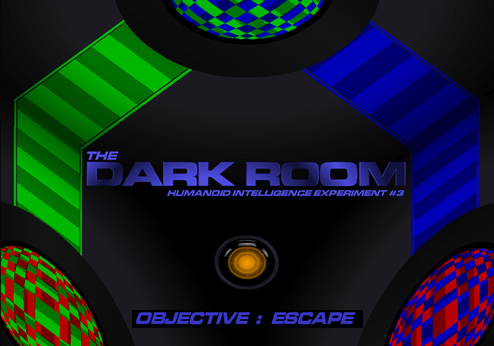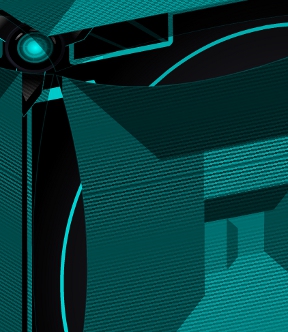
![]() Suddenly, puzzles! Thousands of them!... well, maybe not so many, but still quite a lot. Master trapper extraordinaire Jonathan May finally returns to his celebrated Dark Room series after over half a decade with The Dark Room: Humanoid Intelligence Experiment #3. Think you have what it takes to escape the confines of one of the strangest places ever built? Prove it!
Suddenly, puzzles! Thousands of them!... well, maybe not so many, but still quite a lot. Master trapper extraordinaire Jonathan May finally returns to his celebrated Dark Room series after over half a decade with The Dark Room: Humanoid Intelligence Experiment #3. Think you have what it takes to escape the confines of one of the strangest places ever built? Prove it!
Just like The Dark Complex before and the original Dark Room, this game is controlled entirely with the mouse. Moving your cursor around the screen causes your perspective to move in the same manner, so swing to the left, right, and so forth to look around. Certain spots in each area can be interacted with by clicking on them. Of course, it won't always be immediately apparent what those clicks do; most of the fun in the  Dark Room comes from not only figuring out solutions to puzzles, but what each puzzle actually is, and, in general, each room has its own unique one to solve. Because the movement of the camera and layout might be a bit disorienting for some people, you might find it handy to keep a pen and paper on hand and make your own map and notes to help solve each of the puzzles. (Bonus points for eventual descent into madness and leaving behind only a sheet of paper that reads "All work and no play makes ___ a dull humanoid.")
Dark Room comes from not only figuring out solutions to puzzles, but what each puzzle actually is, and, in general, each room has its own unique one to solve. Because the movement of the camera and layout might be a bit disorienting for some people, you might find it handy to keep a pen and paper on hand and make your own map and notes to help solve each of the puzzles. (Bonus points for eventual descent into madness and leaving behind only a sheet of paper that reads "All work and no play makes ___ a dull humanoid.")
If you have trouble differentiating colour, make sure to turn on colourblind help via the bottom left of the title screen. Doing so will enable a helpful text prompt letting you know the colour of the room you're working on, and whatever colour your mouse happens to be hovering over at the time. If you need a break, just make use of the game's autosave function; leave, and you can pick up right where you left off the next time you start the game back up again by choosing "continue" at the title.
Analysis: It doesn't take a lot to make a puzzle game, but it does take a lot to make one stand out in your memory for longer than it takes to actually complete it. Jonathan May's Dark Room series seems to accomplish that effortlessly. A lot of that comes from the easy marriage between otherworldly design and inventive gameplay. If you ask someone who has played the Dark Complex now, even five years down the road, their reaction might be to narrow their eyes and hiss "the red room" with the same amount of theatrics Lex Luthor might use for cursing Superman. There really is nothing else like it, and getting to experience it on your own for the first time is wonderful and more than a little strange, an experience punctuated by the sort of "Aha!" moments that make puzzle solving so rewarding.
Of course, the Dark Room's sink-or-swim approach to gameplay, not unlike getting tossed without your floaties into the deep end of the pool, means that players who require instruction to grasp the concept and proceed are probably going to be a little baffled and disconcerted here. Being the sort of person with both the pathfinding and problem solving skills of a particularly dense dog with a blanket thrown over it, I initially had a bit of trouble getting my bearings as I moved from room to room, and more importantly, figuring out what was required in each one. The Dark Room series has always demanded a certain willingness to experiment, and the third installment is no different, sporting puzzles that require attention to detail and the ability to think outside the box.
But as challenging as the Dark Room can be, it never feels like it crosses into the realm of the unreasonable. For me, that distinction depends on whether your reaction to any given solution is "Oh, I get it!" or "How was I ever supposed to figure that out?" If we're being honest with each other here, I did need to resort to some help to solve a few puzzles, or at least nudge me in the right direction (dog under a blanket, remember). In most cases, (especially in the Cyan room) I found out that my problem was simply getting disoriented; using omnipresent glowing button as a focal point can really help with this. Once you know what you're doing, you can't help but marvel at how smartly everything is laid out.
While not as big as The Dark Complex, this third game in the series still offers up six rooms and some exceptionally abstract puzzles. The simple truth is that the puzzles themselves aren't usually that complex... instead, it's puzzling out what the puzzle actually is that's difficult. (The puzzle puzzles, if you will... no, you start making sense!) The Dark Room 3 is every bit as captivating as its predecessors, and another feather in the cap of Jonathan May. Whom, might I add, has quite a promising career ahead of him designing devious lairs beneath supervillain hideouts.






Walkthrough Guide
(Please allow page to fully load for spoiler tags to be functional.)
The Dark Room 3 Walkthrough
General Notes:
For the purpose of this walkthrough use this image as a reference for the sides of the cube relative to the button.
There are 6 colors, Red, Blue, Green, Yellow, Teal, and Magenta. Each color has it's own puzzle to solve. You can only escape once you solve all the puzzles.
To enter a room, click the orange button so that the cube has a smooth surface. On that cube there will be a button for blue, red and green. Combine those to make the other three colors. Once a color is over a hole click the orange button again to get back to the other cube mode, and enter a room.
Blue room
Hint: Something is... Different.
The hands are all in the same order, except each face of the cube has one hand out of order. bring that hand to the front.
click the faces of the cube like this: 1x4 2x1 3x2 4x3 5x3 6x4.
Green room
Hint: Connect!
Connect the paths so that one path runs around the 6 faces of the cube.
Follow these steps to solve, starting with Wall #1.
Click the back piece
Click the line, then the back piece
Click the line
Click the rear piece twice, then click the new rear piece once
Click the middle piece once
Click the back piece (the circle) twice
Cyan room
Hint: This room is amazing!
This room is literally a maze. Just find the exit on the uppermost floor.
Click on the walls in the following order: 5 5 2 3 2 2 6 3 2 6 3 3 5 5 1 5 1 1 1 4 4 1
Red room
Hint: Look out behind you!
Click on any wall to get started, then click the opposite way the eye is looking. If the eye is looking at you, click on the same face as the eye. Repeat until the room is complete.
Yellow room
Hint: Try again!
Clicking on the button once will show you some organs. Click two more times and it will show you which organs go where, simply remember what organ went on what face of the cube and put them there by clicking on the button two more times.
Follow these steps to solve, starting with Wall #1.
Click 5x (Brain)
Click 2x (Lungs)
Click 3x (Stomach)
Click 4x (Heart)
Click 2x (Liver)
Click 1x (Kidneys)
Magenta room
Hint: Play Matchmaker
Moving your mouse up, left, or right will cause the shapes to change on the faces. There are 3 matching pairs. Match each pair to complete the room.
Move the mouse over the symbol on each wall in the following directions: 1=left 2=down 3=right 4=down 5=down 6=left
The Exit room
Now that all 6 rooms are completed it's time to find the exit room. First off take note of the flashing, rotating symbol on 4 of the walls in each completed room.
If you close the door to a room you can peep into it through the tiny hole. You need to be able to see the same symbol through the colored wall as you can in the same-colored room.
Use the colored panels in the switch room to move the colored walls into the correct positions.
The correct order, starting from Wall #1, is:
BLUE
MAGENTA
CYAN
RED
YELLOW
GREEN
The arrangement of the switches, starting from Wall #1 is:
Bend
Straight
Straight
Bend
Straight
Bend
Click on the orange button when this is correct and the room should be white.
Exit through the door on the floor to win the game.
Posted by: Kero |
February 15, 2011 8:45 PM
|
February 15, 2011 8:45 PM
The game is very simple to control (but it can be disorienting, especially for the uninitiated). Here's what to do:
Position the mouse in the center of the window, vertically and horizontally, to stabilize control.
Move the mouse toward one of the edges to move the camera in that direction.
Then move the mouse back to center to stabilize it once again.
Posted by: Jay |
February 16, 2011 12:44 AM
|
February 16, 2011 12:44 AM